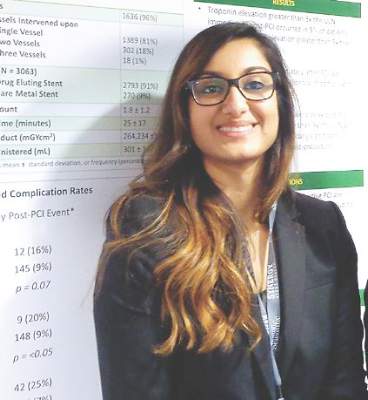AT CARDIOVASCULAR RESEARCH TECHNOLOGIES 2016
WASHINGTON (FRONTLINE MEDICAL NEWS) – After elective percutaneous coronary interventions, troponin levels are an important predictor of adverse events, including cardiac events, and should be evaluated, according to a retrospective analysis.
“In the setting of elective PCI for patients with stable angina, there has been controversy regarding the utility of measuring troponin despite a class IIa American Heart Association/American College of Cardiology guideline recommendation. Our data support the guideline,” Dr. Hannah I. Chaudry reported at Cardiovascular Research Technologies 2016.
According to Dr. Chaudry, troponin, although almost always ordered prior to and after PCI, is no longer routinely consulted at many centers after elective procedures. Her data suggest that it should not only be consulted but the results are actionable.
“After elective PCI, patients with elevated troponin have a significant risk of an adverse event. Our data suggest these patients should be monitored more closely, which may include an extra day of observation,” said Dr. Chaudry of Dartmouth Hitchcock Medical Center, Lebanon, N.H.
In this study, data were obtained and evaluated for 2,861 elective PCIs performed over a recent period of roughly 10 years. The retrospective cohort analysis was restricted to 1,709 PCIs in which patients had normal troponin levels prior to the PCI and then underwent uncomplicated and successful procedures. The analysis was conducted with two definitions of elevated troponin; the stricter 5 times (5X) upper limit of normal (ULN), which is greater than 0.15 ng/mL, and a less strict 3X ULN (greater than 0.09 ng/mL).
Of the patients in this analysis, 5% had a troponin elevation above 3X ULN and 3% had a troponin elevation above 5X ULN immediately after the procedure. A peak post PCI elevation of more than 5X ULN, which included measurements taken 24 hours or more after PCI, was observed in 10%. The rate of in-hospital adverse events was higher in those meeting any of these troponin elevations, compared with those who did not.
Specifically, the rate of in-hospital cardiac events in those meeting the greater-than-3X ULN cut-off immediately after PCI was 9%, compared with 3% in those who did not. For those meeting the 5X ULN cut-off immediately after PCI, the rate of cardiac events was 11%, compared with 3% for those who did not. For those with a peak postprocedure troponin of more than 5X ULN, the rates of any post PCI event (25% vs. 7%) and cardiac events (17% vs. 2%) were both greater. All these differences were statistically significant at P less than .05.
According to Dr. Chaudry, these data have immediate clinical relevance. She noted that troponin levels are among prognostic markers in PCI conducted for acute MI, but many centers do not require documentation of troponin after elective procedures because of conflicting data regarding their predictive value, even though they are frequently obtained.
One of the strengths of this analysis was that it was restricted to patients without successful uncomplicated procedures, yet the troponin levels remained significantly predictive of complications.
“These data indicate that elevated troponin does have predictive value and should be evaluated in all patients,” Dr. Chaudry said. While a normal troponin in the absence of other complications may be reassuring when considering a same-day discharge, she suggested an elevated troponin, including a troponin of more than 3X ULN, supports further observation.
The meeting was sponsored by the Cardiovascular Research Institute at Washington Hospital Center. Dr. Chaudry reported no financial relationships relevant to this study.



